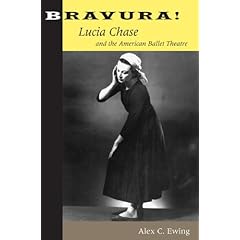Just FYI, I’ve finally managed to reduce my novel’s Amazon price from $17.99 to $14.99. That’s the print price; the Kindle is $9.99. The endlessly wonderful James Wolcott has given me yet another shout-out — thank you Mr. Wolcott! And how sweet is this, and this!
I haven’t participated in a meme for a long time and so thought I’d take the one posted by Laurel-Rain in her Seasons blog (the last link above). The rules are to find the book nearest you, turn to page 56 and write the 5th sentence (and maybe a sentence or two after that for context, if you like). For me, that book is

Bravura! Lucia Chase and the American Ballet Theatre by Alex C. Ewing (Chase’s son), which I received for review purposes. I’m about a quarter of the way through; so review coming soon. Here’s the passage:
“Lucia would have had to be blind not to see that Mordkin was being pushed out of the picture. Yet she was most decidedly not the author of the early plans for Ballet Theatre, nor was she calling the critical shots. Other than providing the seed money for Pleasant to proceed with his grand design, Lucia had made a strict and unequivocal effort to stay out of management.”
So far, my favorite parts have been more about Lucia’s personal life than the details of setting up the company — such as her relationship with her husband, who died tragically young, when the couple’s two children were still babies. For years after his death, she would write him notes, telling him what she was doing, thinking, about her life. A way of keeping him around, I guess. So heartbreaking. Right now I’m reading about her love / hate relationship with Agnes de Mille — delicious fun!

That’s nonfiction. Here is a novel, Picking Bones From Ash, that was just about the same distance away from me. It’s by my friend, Marie Mutsuki Mockett, and I recently finished it and wrote a review of it on Goodreads. I absolutely loved it; I learned so much — about Japanese culture, European culture, Japan itself, Buddhism, classical music, historical artifacts, how to discern the period in which a piece of art was made — just read it, it’s filled with such beautiful detail and the story is so suspenseful you really won’t be able to put it down after a certain point. Anyway, here is page 56’s fifth sentence:
“We continued to spend time together on the weekends and during the holidays when I was home in Hachinohe. In the middle of my second year of college, however, Masayoshi began to act a little bit strange again. It all started when his father had a small stroke around the same time that I was caught up in preparing for the annual Messiah concert.”
One other book I just received in the mail and am currently reading is this:

Anatolia and Other Stories is a collection of short stories by Anis Shivani, whose work I became familiar with in the literary journal Boulevard. According to a quote by award-winning novelist Laila Halaby on the inside cover, the collection “takes us around the globe in stories that juxtapose old and new, east and west, with characters that do their best to navigate the generational / religious / cultural / socioeconomic tensions inherent in our global economy. Shivani’s observations are dead-on, especially when dealing with themes of loss, family dynamics, and subtleties of power.”
Finally, here’s another book related to dance that I didn’t have time to review, but that is getting good reviews.

The Sugarless Plum, by Zippora Karz, details the New York City Ballet dancer’s struggles coping with the dangerous and life-altering Type 1 Diabetes, which she was diagnosed with at age 21, while still a corps member in the company. Despite the disease she nevertheless managed to rise through the ranks and enjoy a solid, 16-year ballet career.
If anyone wants to participate in the meme, just link back to this post on your blog, or, if you don’t have a blog, you can write the book’s passage in a comment here.







Bravo to “Bravura!” This book, page by page, is a transfixing history of Lucia Chase and The American Ballet Theatre. Detailed, but nuanced, Alex Ewing presents an honest story that for dancers and dance lovers everywhere is both familiar and surprising. Beautifully written, Alex Ewing has an eye of an historian and a heart of a dancer.